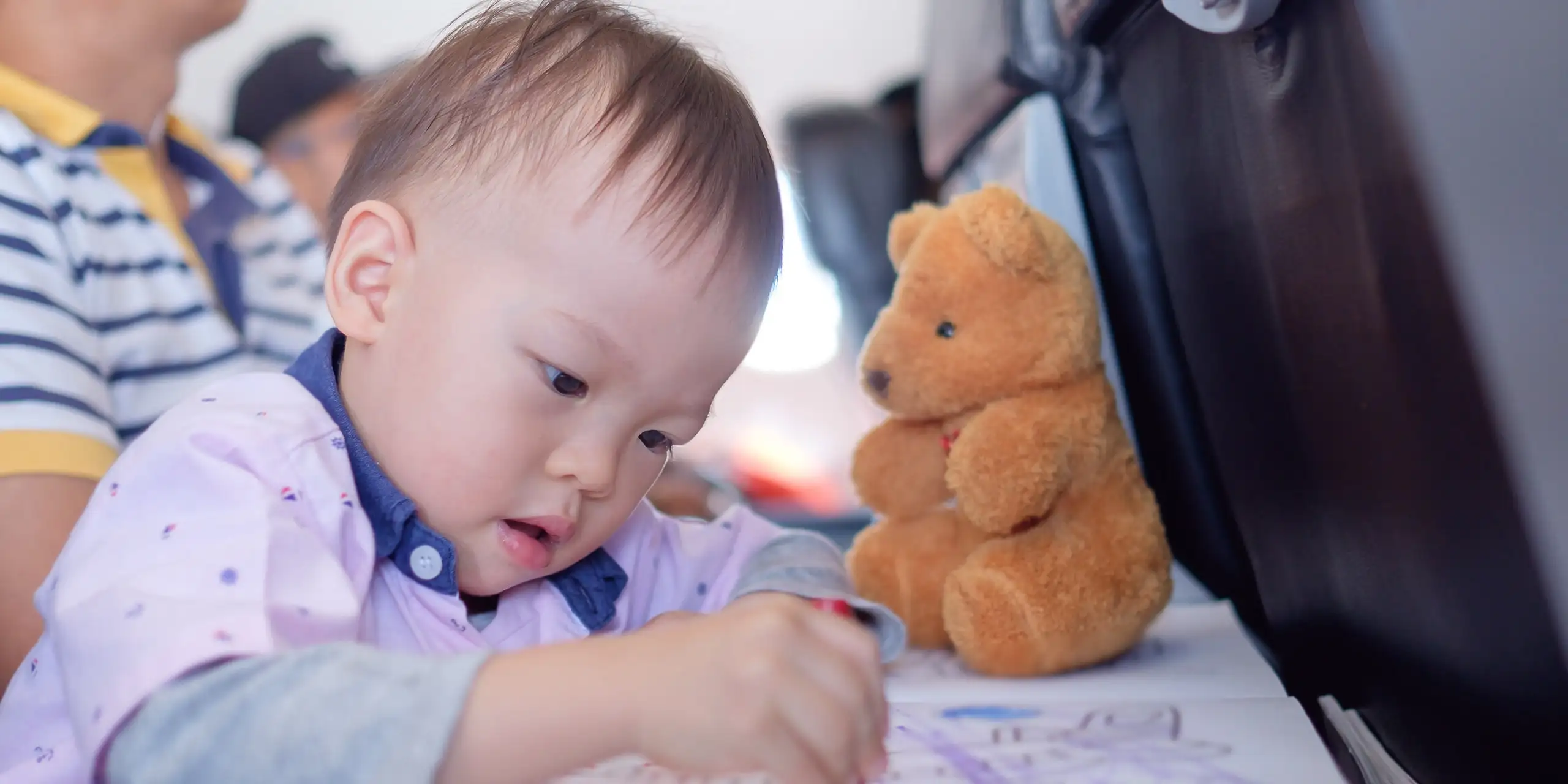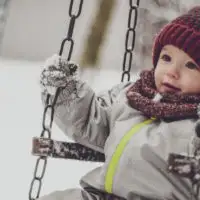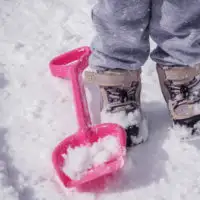Flying with a baby can be an intimidating and overwhelming process. Unless you plan on wearing your baby the entire trip or have a car seat and/or stroller lined up at your destination, you’ll be traveling with a lot of extra baggage. On top of that, different airlines have different policies, and while passing through security, different rules apply to parents traveling with infants regarding liquids. Ease the process with this go-to guide on flying with a baby.
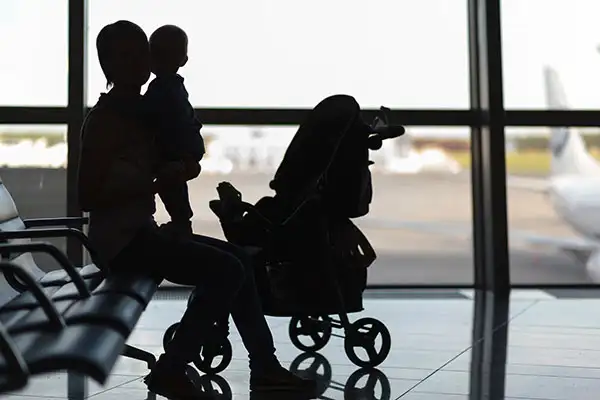 Major U.S. Airline Regulations for Air Travel With Baby
Major U.S. Airline Regulations for Air Travel With Baby
Delta
Children’s strollers and seat restraints are not counted as part of the standard baggage and therefore can easily be checked for free. These items may be checked curbside, at the ticket counter or the gate.
Child restraint seats may be brought on the plane in certain circumstances. For instance, if there is an open passenger seat in your row, you may place your child in an FAA-approved child restraint in that seat during takeoff and landing. If an empty passenger seat is not available for your child restraint, the item must be checked at the gate by a Delta representative.
US Airways
One fully collapsible stroller or one child restraint device or car seat can be checked at no charge.
JetBlue
A lap infant may have one diaper bag, one stroller and one car seat. Infants who are traveling for free do not qualify for the checked baggage allowance. If checking a child safety seat, it will not count as one of your checked bags and there is no fee assessed. However, playpens and other infant beds will count toward your checked baggage allowance and must meet size and weight requirements.
United Airlines
Customers may carry on one diaper bag and government-approved child seat, in addition to the maximum carry-on baggage allowance. United Airlines also accepts one stroller or one car seat as checked baggage — free of charge — for each child traveling on the flight. The airline is not liable for damage to strollers, however, and customers cannot purchase excess valuation for them.
American Airlines
Carry-on and checked item allowances for children vary depending on whether or not a seat is purchased for the child. If a seat is purchased for a child, the standard carry-on baggage and checked baggage apply.
Related: 10 Ways to Save on Baggage Fees
If a seat is not purchased for an infant, that infant does not have a carry-on or checked baggage allowance. However, the following items are allowed over and above the carry-on allowance for the adult traveling with an infant: an approved safety seat for a lap or ticketed child (may also be checked); umbrella stroller for lap or ticketed child; and a diaper bag for lap or ticketed child.
Southwest
Customers traveling with children are allowed to check one stroller and one Child Restraint System (CRS) or car seat per child without charge. This is in addition to the regular free baggage allowance. The stroller and CRS or car seat allowance applies to any type of stroller (umbrella, full size, jogging stroller) and CRS or car seat. The customer may check the stroller and CRS or car seat at the curb, ticket counter or gate. Southwest Airlines will not assume liability for damage to strollers, CRS’s or car seats.
An optional Southwest-branded reusable car seat/stroller bag is available for purchase at any Southwest Airlines ticket counter for a $15 one-time fee.
Frontier
Babies are able to travel on their parent’s lap from one week of age until their second birthday. Seats with approved car seats installed are also an option for those traveling any airline, including Frontier. A stroller and car seat may be checked at the gate or with luggage free of charge when traveling with a child. A diaper bag may be carried on free of charge when traveling with a child.
Virgin
Infant amenities like bassinets vary by aircraft. When a ticket is booked, inquire to see if the flight you’re traveling on (likely the longer distance flights, with larger aircrafts, have bassinet options) has a bassinet aboard. Meals for lap infants can be requested ahead of time, as well as for those who are ticketed for seats with approved car seats. One car seat and one stroller are able to be checked for free along with the standard approved baggage allowance.
Spirit
According to the Contract of Carriage for Spirit Airways, if there is any space in the cabin after boarding, or if a seat has already been purchased, it is encouraged that an infant seat be installed for any child under two years of age traveling with an adult or parent. A car seat, stroller and infant bag are allowed free in addition to checked baggage allowances.
TSA Requirements for Air Travel With Baby
According to the TSA:
“Medically required liquids, such as baby formula and food, breast milk and medications are allowed in excess of 3.4 ounces in reasonable quantities for the flight. It is not necessary to place medically required liquids in a zip-top bag. However, you must tell the Transportation Security Officer that you have medically necessary liquids at the beginning of the screening checkpoint process. Medically required liquids will be subjected to additional screening that could include being asked to open the container. We recommend, but do not require, that medication be labeled to facilitate the security process.”
Related: Best Products for Traveling With Breastmilk
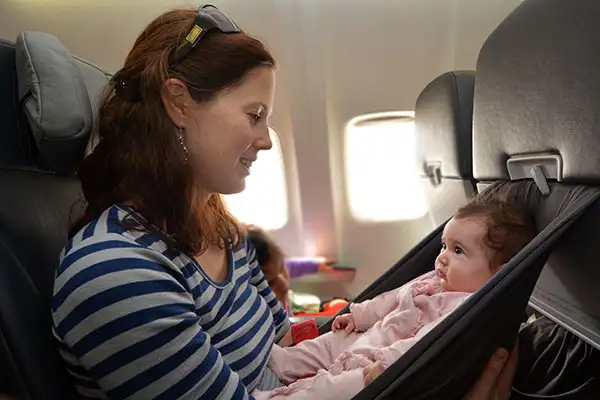 Car Seat Safety Tips for Air Travel With Baby
Car Seat Safety Tips for Air Travel With Baby
Installation
Car seat safety experts (like the Car Seat Lady) recommend buying a seat for an infant and installing a car seat right in the plane seat in case of turbulence. Face the seat forward if the baby is old enough to be seated as such (the recommendation is at least 2 years or older); face it backward if babies are still rear-facing in the car and if the car seat adheres to FAA regulations (most car seats sold in the U.S. already do, but check your manual to be sure).
If your flight(s) have empty seats on the plane, it’s worth asking the agent at the check-in counter if it’s possible to install your car seat, even if you haven’t paid for a seat for it.
Guidelines
Some families traveling with car seats have encountered difficulties with flight attendants unaware of their own airlines’ policies regarding rear-facing car seats when they impair the ability of the person directly in front of the car seat to recline. Travel with a copy of the airline’s guidelines on infant travel, including car seat orientation.
Damage Protection
If you decide not to bring your car seat on board, the safest place to check it is at the gate. In order to protect it from getting tossed around and damaged, car seat technicians recommend bubble wrapping the seat in a box. If that’s not a feasible option, padded bags can be found on Amazon.com, which can provide the fabric, and to a lesser extent — the seat itself — some protection. This is also the best method for checking a stroller, since they can get damaged when gate checked (and many airlines don’t accept liability for stroller damage). Packing the stroller in a bag can protect its wheels from damage, which is where most strollers are damaged in transit.
Related: 5 Travel Cribs for Families With Infants
Long Haul Flights
If you’re traveling on a long-distance flight, you might not want to hold your infant the entire trip. Outside of buying a seat, those with small babies may want to consider trying to secure a bassinet. Bassinets can only be placed in bulkhead seats, and even if you’ve ordered one, there is no guarantee it will be available when you get on board. Some airlines, like Lufthansa, don’t offer bassinets on every plane, and others, like Emirates, offer them on a first-come first-served basis, so book early and call back several times to confirm. The weight limit for these bassinets is about twenty pounds.
Small changing tables are usually available in the lavatories of most international flights, though, like bassinets, their availability depends on the aircraft. Bring a changing pad on board in case there is no table available, or the one in the bathroom happens to be broken (that’s happened to our family before!). Ask a flight attendant where is best on the plane to change an infant if this is the case.
Tips for Flying With a Baby
- Give baby a bottle or pacifier during take-off and landing. The changes in air pressure during take-off and landing can cause pressure in baby’s ears. Let the little one suck on a bottle or pacifier during these times. Both will help baby to swallow continuously, which helps to clear the ears. A bottle or pacifier will also help keep baby quiet during the flight so as not to disrupt the other passengers’ flight.
- Bring earplugs or other treats for your fellow flyers. Baby is bound to get fussy during a long flight. Keep the peace with your other passengers by offering them earplugs to drown out the sound of crying. If they don’t accept, offer to buy their drink or snack when the flight attendant comes around. The gesture will say you’re sorry for any discomfort you may have caused them during the flight.
- Buy an airplane seat for baby. It’s true that children younger than 2 years can be “lap babies” on airplanes for free, but it’s much safer to have your child strapped into his or her car seat during take-off, landing and turbulence than in your arms. According to the FAA, most car seats are just as safe in airplanes as they are in motor vehicles. Plus, having baby in her own seat allows mom to spread out in her own seat — hands are fully free to read a book!
- Book flights with as few connections as possible. If you do need to book a flight with a layover, choose one with a relatively long stop to avoid having to run through the airport with your child and all your baby gear. Also, find out if there is a play area at the airport for little ones. Read our tips on the best ways to keep your kids busy at the airport.
- Keep your stroller with you until you board. Maneuvering through a crowded airport loaded with bags and your innocent one is tough enough, so bring your stroller and use it to hold everything, just as you would on any outing with baby. Airlines will allow you to gate check your stroller, so you’ll have it up to until you depart and immediately upon landing.
Our team of parents and travel experts chooses each product and service we recommend. Anything you purchase through links on our site may earn us a commission.

